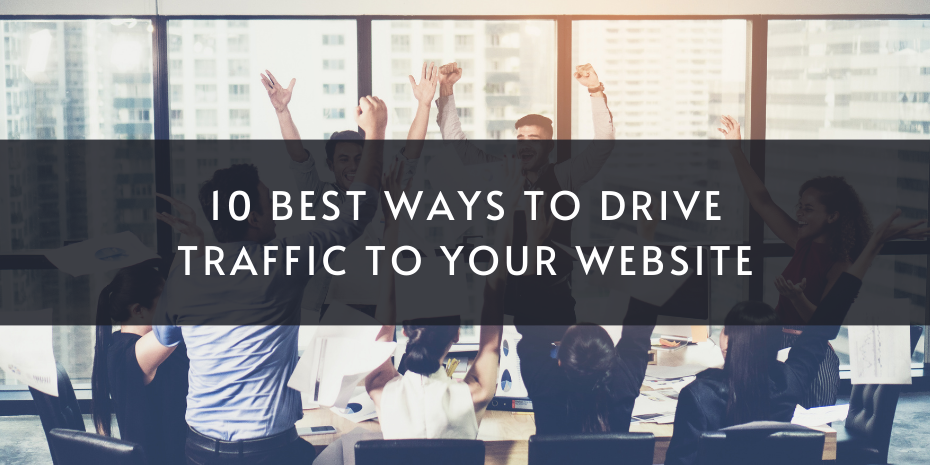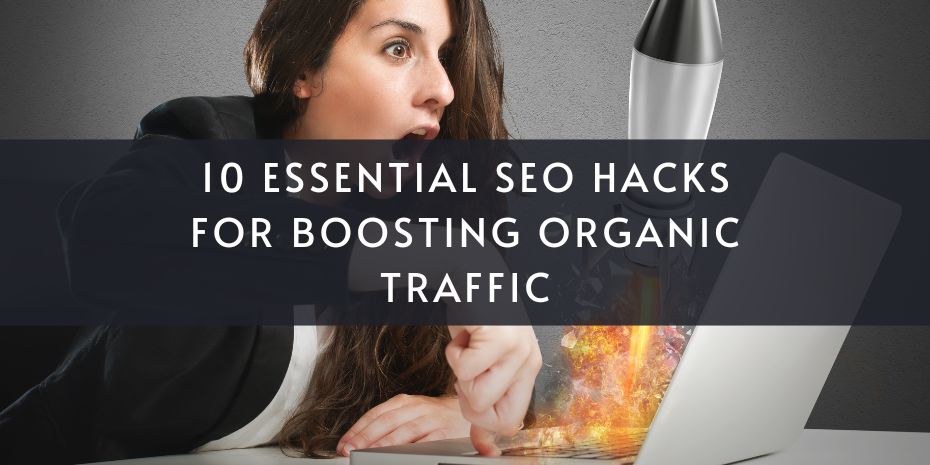Have you ever wondered how to maximize the traffic to your website and reach a larger audience? With the digital landscape constantly evolving, driving traffic to your website has become increasingly important for businesses and individuals looking to grow their online presence. In today's competitive online world, it's crucial to utilize effective strategies to ensure your website gets the attention it deserves.
In this article, we will explore the 10 best ways to drive traffic to your website, sharing valuable insights and practical tips to help you increase your website's visibility and attract more visitors. Whether you're running an e-commerce store, a personal blog, or a business website, implementing these strategies can make a significant difference in driving traffic and ultimately achieving your online goals.
1. Search Engine Optimization (SEO)
Implementing SEO best practices is essential for improving your website's ranking on search engines and driving organic traffic. Start by conducting keyword research to identify high-level keywords relevant to your content. Incorporate these keywords strategically throughout your website's content, including headings, meta tags, and image alt text.
Actionable tips include creating high-quality, relevant content that provides value to your audience. Regularly update your website with fresh content to keep users engaged and attract search engine crawlers. Utilize on-page SEO techniques such as optimizing loading speed, improving mobile responsiveness, and creating clean URL structures.
Real-life examples showcase how implementing SEO best practices can lead to tangible results. For instance, a case study could demonstrate how a website saw a significant increase in organic traffic and conversions after optimizing their content and implementing a strong backlink strategy. By following these recommendations and continuously monitoring your website's performance, you can enhance your online visibility and reach a wider audience.
2. Content Marketing
Creating high-quality and engaging content is essential to attract and retain visitors to your website. Start by using high-level keywords relevant to your target audience to optimize search engine visibility. Additionally, provide actionable tips or recommendations related to your industry to add value for your readers. For example, a blog post about digital marketing could include tips on social media strategies or SEO techniques.
Incorporating real-life examples or case studies can further illustrate the concepts discussed and make your content more relatable to your audience. Sharing success stories or testimonials from clients can help build credibility and trust. Remember to keep your content concise and readable by maintaining a maximum of 177 words per paragraph to keep readers engaged and interested. By consistently offering valuable and relevant content, you can attract and retain visitors to your website, ultimately driving traffic and increasing conversions.
3. Social Media Marketing
When utilizing social media platforms to promote your website and engage with your target audience, it is essential to use high-level keywords that are relevant to your industry or niche. By incorporating these keywords into your social media posts, you can increase visibility and attract the right audience to your website. Conduct keyword research to identify the most effective keywords for your content and ensure they are strategically placed in your posts to maximize reach.
One actionable tip is to create a content calendar outlining when and what you will be posting on each social media platform. This will help you stay organized and consistent with your messaging, ultimately building brand recognition and driving traffic to your website. By planning ahead and scheduling posts in advance, you can ensure that your content remains relevant and engaging to your target audience.
A real-life example of successful social media promotion is the case of Glossier, a beauty brand that effectively utilizes Instagram to showcase user-generated content and engage with their customers. By reposting photos and testimonials from their followers, Glossier creates a sense of community and loyalty among their audience, ultimately driving traffic to their website and increasing sales. This demonstrates the power of leveraging social media platforms to foster relationships with your target audience and promote your website effectively.
4. Email Marketing
Building an email list is crucial for driving traffic back to your website. Start by creating compelling opt-in forms on your site with language that resonates with your audience. Use high-level keywords in your email campaigns to capture the reader's attention and encourage them to click through to your website. Offer exclusive content or promotions to incentivize sign-ups and keep subscribers engaged. Segment your email list based on interests or behaviors to send targeted campaigns that are personalized and relevant.
For example, a skincare brand could segment their email list by skin type and send personalized product recommendations based on the subscriber's needs. By sending targeted campaigns, you can increase open rates and click-through rates, ultimately driving more traffic to your website. Remember to track and analyze the performance of your email campaigns to continuously optimize and improve results.
5. Pay-Per-Click (PPC) Advertising
To effectively drive traffic to your website through targeted ads on search engines and social media platforms, it is crucial to use high-level keywords that align with your business goals and target audience. Conduct thorough keyword research to identify the most relevant and high-performing keywords that will attract potential visitors to your site. Utilize tools like Google Keyword Planner or SEMrush to gain insights into keyword search volume, competition, and potential impact on your ad campaigns.
Actionable tips include creating compelling ad copy that highlights your unique selling points, using attention-grabbing visuals, and optimizing your landing pages for conversions. For example, a yoga apparel brand could target keywords like "best yoga leggings" or "athleisure wear" to reach fitness enthusiasts on search engines and social media. By tailoring your ad content to resonate with your target audience and leveraging data-driven insights, you can maximize the effectiveness of your campaigns and drive quality traffic to your website.
6. Influencer Marketing
Partnering with influencers in your industry can significantly boost your website's visibility and drive traffic to your site. By collaborating with influencers who have a large and engaged following, you can tap into their audience and leverage their influence to promote your website. When selecting influencers to partner with, make sure they align with your brand values and target audience to ensure the partnership is authentic and effective. By using high-level keywords in your content and collaborating with influencers who are experts in your industry, you can reach a wider audience and increase your website's reach.
For example, a fashion brand could partner with fashion influencers to showcase their latest collection and drive traffic to their online store. By creating engaging and visually appealing content that resonates with the influencer's followers, the brand can generate interest and increase sales. Additionally, by providing influencers with unique discount codes or exclusive promotions to share with their audience, the brand can track the success of the partnership and measure the impact on their website traffic and conversion rates.
7. Guest Blogging
Guest posting on popular blogs in your niche is an excellent way to expand your reach and drive traffic back to your website. By targeting high-level keywords in your guest posts, you can increase visibility and attract a new audience interested in your content. To maximize the impact of your guest posts, provide actionable tips or recommendations related to the topic that readers can implement immediately.
One effective strategy is to incorporate real-life examples or case studies to illustrate the concepts discussed. This not only adds credibility to your guest post but also makes the information more relatable and engaging for readers. By sharing practical advice and showcasing relevant experiences, you can establish yourself as an authority in your niche and build trust with the audience.
Overall, guest posting on popular blogs can significantly boost your website traffic and increase your online presence. By following these guidelines and creating quality content that resonates with readers, you can attract a wider audience and drive more traffic back to your website, ultimately helping you achieve your business goals.
8. Optimize Website Speed and User Experience
To ensure your website loads quickly and provides a seamless user experience, focus on optimizing its performance. Use tools like Google PageSpeed Insights or GTmetrix to analyze your website's speed and make necessary improvements. Minimize HTTP requests, optimize images, leverage browser caching, and enable compression to reduce load times.
Implement lazy loading for images and videos to prioritize the loading of content above the fold, ensuring users can start interacting with your website immediately. Consider using content delivery networks (CDNs) to distribute content geographically and reduce latency. Additionally, use responsive design to ensure your website is optimized for all devices, providing a consistent user experience across various platforms.
A real-life example of effective website optimization is Amazon. The e-commerce giant prioritizes speed and user experience, ensuring their website loads quickly and efficiently. By implementing a clean and simple design, optimizing images, and streamlining the checkout process, Amazon keeps visitors engaged and coming back for more, ultimately leading to increased conversions and customer satisfaction.
9. Utilize Google My Business
Claiming and optimizing your Google My Business listing is crucial for improving local search visibility and driving traffic to your website. By using high-level keywords relevant to your business and location in your listing, you can increase the chances of appearing in local search results when potential customers are looking for products or services like yours. Make sure to fill out all relevant information, such as your business address, phone number, website, hours of operation, and photos to provide a comprehensive overview of your business to potential customers.
One actionable tip is to regularly update your Google My Business listing with any changes to your business information or promotions. This not only keeps your listing accurate and up-to-date but also signals to Google that your business is active and relevant. Additionally, encourage satisfied customers to leave positive reviews on your Google My Business listing, as this can boost your credibility and improve your local search rankings. For example, a local restaurant saw a significant increase in website traffic and reservations after claiming and optimizing their Google My Business listing with high-quality photos and positive customer reviews.
Another recommendation is to use Google My Business features such as Posts, Messaging, and Q&A to engage with potential customers and provide them with helpful information. By regularly posting updates, responding to messages, and answering common questions, you can showcase your expertise and build trust with your target audience. For instance, a local boutique saw an increase in foot traffic and online sales after actively engaging with customers through Posts and responding promptly to inquiries on their Google My Business listing.
10. Engage with Online Communities and Forums
Engaging with online communities and forums related to your website's niche is a powerful strategy to increase visibility and attract targeted visitors. By actively participating in discussions, sharing valuable insights, and promoting your content in a non-intrusive way, you can establish yourself as an authority in your field and drive traffic to your website. Make sure to use high-level keywords in your posts and comments to optimize them for search engines and reach a wider audience.
For example, a travel blogger could join travel forums and share tips on budget-friendly destinations or unique travel experiences, while subtly mentioning their own blog as a valuable resource for further information. By providing genuine value to the community and building relationships with fellow members, you can organically grow your website's traffic and attract visitors who are genuinely interested in your niche.





